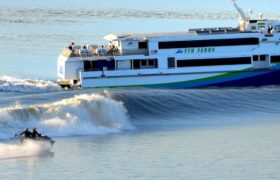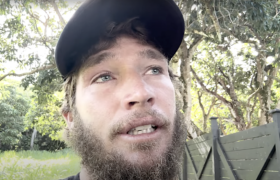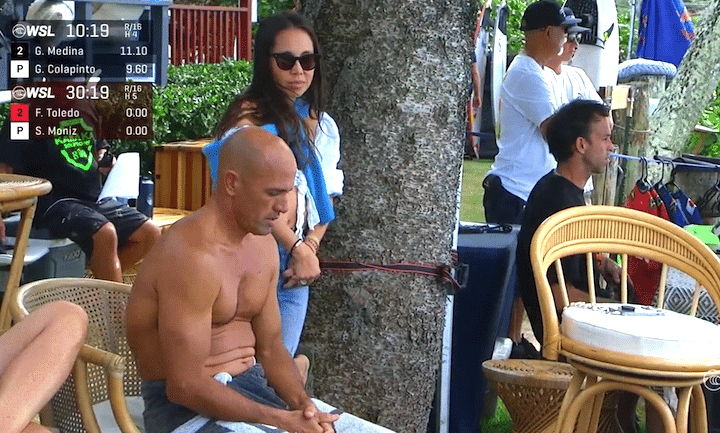Gabriel Medina and Barron Mamiya escape by a
hair.
Today I come to you from Amsterdam. My first
report from Pipeline came from the French Alps, near the Italian
border. There’s a comical juxtaposition of covering something as
whimsical as professional surfing from these places, the realities
of each so disparate in both physical miles and headstate.
It’s a few years since I was last here, and I swore it would be
my last, owing to a particularly involved afternoon of mescaline.
But it’s been very pleasant so far, this four-dimensional lattice
world of canals and glass, a rippling synesthesia of cheese, sex
toys and drug paraphernalia.
We walked for miles in the city yesterday in a kaleidoscopic
bliss. Tall, helmetless people on bikes seemed to flow from every
direction. Angular blond girls in camel coats shimmered over
pavements. Shop windows popped with lurid colours. It doesn’t
matter if you’re pedaling drugs, dildos or children’s toys, the
marketing remains the same, eyes and minds are captured by colour
and choice. Vices of every flavour are neon lit and unashamed.
And always, the heady tang of weed fills the air. Like starlings
alighting then flitting from telephone wires, groups of young men
and women spill in and out of coffeeshops, giggling into the
brightness of the street with ash-faced glassy smiles and slanted
laughter.
My favourite moments are the ordinary ones, the ones where you
begin to see the fabric of the city. The thin man taking out his
bins, shuffling in pink Crocs several sizes too small. The old
Vinta windsurfing board lashed to someone’s private canal dock,
floating daggerboard down on the browned green water, eye level
with the small windows. The old woman feeding slices of bread to
merganser ducks and shooing the gulls, which, as she told us in
Dutch, peck holes in the duck’s heads. The kids’ nursery right next
door to prostitutes’ windows. Hookers need childcare too.
Or the guy in the silver Corsa, pumping out quality techno on
narrow streets at ten in the morning. Whether it was the acoustics
of the alley or the bass of a sound system that seemed outrageous
in the context of the car it was fitted in, I swear the whole
street were primed and appreciative of that beat drop.
Amsterdam is a city distilled to the fundamental and authentic
condensate of human existence. It’s a truth you’ll find equally in
the ancient kinky artefacts of the sex museum; in the drawn or
hungry faces of the red light district; or in the hazy contentment
of the coffeeshops.
One way or another, we all want to get fucked.
We were directionless and delighted by this simple premise, by
the simple joy of floating in a river of humanity. We lay on our
backs and let the city carry us.
There’s an acclimatisation phase here, much like there is when
you go somewhere of high altitude. Your body and mind will feel
different, often not quite your own. Accepting this as normality is
the key, and once you establish your new baseline, then you can
begin to push a bit harder.
So it’s amidst this context that I returned to my hotel last
night, diligently firing up YouTube to see Sunset Beach, labouring
under the burden of a north swell. Takeoffs were uncertain,
sometimes prone. Clean walls were hard to find, end sections
ephemeral.
“A waterman’s wave” is the standard refrain of the Sunset Beach
apologist, typically a white male aged 50+. And of course it’s a
“huge playing field”, or something to that effect, even though the
analogy of a playing field would suggest that all sections of the
area are amenable to play.
A military analogy might be more fitting, something as simple as
a battleground. It’s all technically in play, it’s just that
survival is only assured by being in one indistinct and
unpredictable place at just the right time. Everywhere else you’ll
probably get blown to shit.
I don’t mind it. It doesn’t always make the most exciting heat
viewing, but there’s an argument for the slightly chaotic nature of
it. The vibe isn’t dissimilar to the straats of Amsterdam, as it
happens. When you overlook the oddities, accepting that at any
given moment you might feel simultaneously teetering on the edge of
control or nirvana, or there could be unpredictable, searing turns
at any time, then you can begin to enjoy it.
Anyone can win here, and anyone might lose. When single turns
are acceptable currency for mid-high range scores, and single digit
heat totals are often enough, sheer circumstance can be all you
need.
Kaipo likes to call it a “time bandit”.
Or I should say that Kaipo still, relentlessly, likes to call it
a time bandit, even if no-one else ever does and he still needs to
explain the analogy every time he says it.
Waves that offered more than two solid opportunities for turns
were rare today. Mostly, the day was marked by struggle. There’s
little to be done in the way of establishing rhythm at Sunset on
days like today. Staccato might be the best you can hope for.
Challenging that notion was Ethan Ewing, who performed the kind
of cutback that should make any remaining sceptics nod in quiet
acknowledgment, whilst his many acolytes spit in vindicated
delight.
His backside rail line drew through the wave face like
cheesewire. His body torque was statuesque, back arm high and
lightly bent. His connection with the section like that of a
watchmaker.
It was a turn that few might have even conceived, and it marks
Ewing out not just for his lauded style and approach, but for his
reading of water. The foundations beneath a dazzling
architecture.
My other major note belonged to Matt McGillivray, another man
with the capacity to make heavy water look smooth. An 8.33 was
rightfully garnered for two achingly committed turns on his
forehand that few could match today. He advanced to the round of 32
alongside heat winner Eli Hanneman, sending the unlikely spectre of
Gabriel Medina to the elimination round.
Medina has seemed slightly out of kilter this season so far. The
waves he’s had to work with so far in both comps have hardly been
conducive to rhythm, but there’s an uncertain flutter in his
backhand that caused me some consternation. If he really is
carrying as much extra muscle as we’ve been led to believe, these
kinks might take a while to iron out. He advanced from the
elimination round nonetheless, taking the victory with Sammy Pupo
in second place and wildcard Keanu Asing out of the competition and
facing a short journey home.
Current yellow jersey Barron Mamiya also faced the elimination
round, but also stayed alive by taking the heat win. Fred Morais
progressed in second. Both advance at the expense of Kai Lenny,
whom you’d think might have been a wildcard in the truest sense on
a day like today.
Looking ahead to the forecast and likely cleaner conditions,
you’d have to think it’s anyone’s game, providing they can lay a
rail and match Sunset’s power with their own. Some barrels were had
and scored today, notably Jordy’s 9.33, but this will be a
competition decided by turns, ideally performed on closeout
sections.
Look to Jordy, Ethan, John. Maybe Connor O’Leary and Ryan
Callinan, too. And I’m interested to see what rookie Cole Houshmand
might bring to a match-up with Jack Robinson in the final heat of
the round of 32.
One man who will not be a threat is Filipe Toledo, shorebound
and on sabbatical. He seemed sprightly and mildly regretful in the
booth today, joining Turpel and Mendes, perhaps now that the
looming shadow of Pipeline is gone.
But he assured us that he will still be surfing, still going on
surf trips. And he reminded us he’d done a lot of crying about his
decision. Three full days would you believe.
Credit to Turpel, who feinted with opening praise about all the
locations Toledo has won, before jabbing with the combo of Pipeline
and Teahupo’o as places that have “challenged” him.
“Is that still a fair statement?” Joe hoisted, suddenly shocked
at the out of body experience that almost made him ask a real
question. “Are you planning on working on your profile for these
events?” Turpel followed, retreating into the clammy safety of
euphemism once again.
Toledo was typically evasive. “I can’t tell you guys that” he
initially responded, before pretending he was joking. As a teacher,
I’ve overheard enough conversations between high school boys
claiming to have girlfriends in other towns to know the truth
behind his mock humour.
But that’s enough Toledo for me. He controls his own fate now. I
wish him the best of health and luck, and however it plays out,
it’ll be a hell of a story.
Onto the knockout rounds we go with the men who still
matter.
Now if you’ll excuse me, now that I’m fully acclimated, I’m off
to swirl and spin through the straats of Amsterdam like it’s a
platform game.






